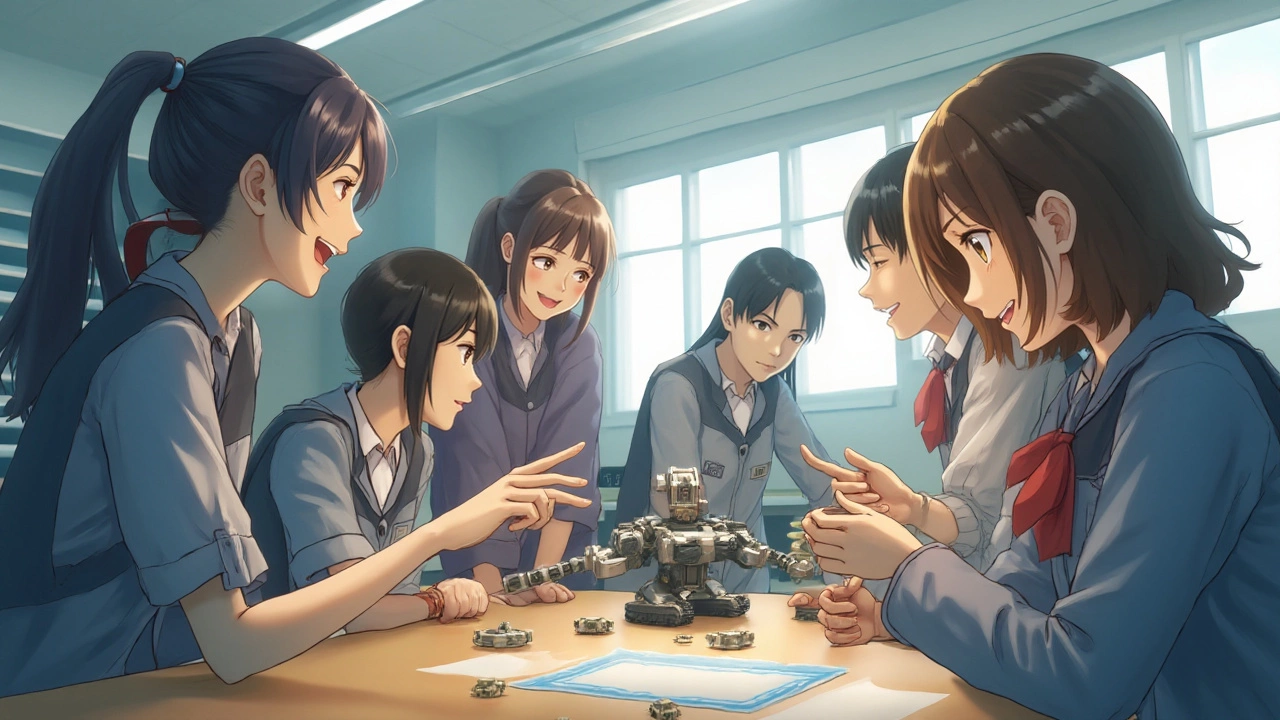-
24
- 0

Unveiling the World's Top-Rated Education Systems: A Deep Dive
Education is a fundamental aspect that shapes societies and molds future generations. Around the world, education systems are as diverse as the cultures they emerge from. However, a few countries consistently lead the pack in terms of delivering high-quality education.
Delving into the unique approaches of these top education systems can provide valuable insights and lessons for improvement elsewhere. From Finland's child-focused methodologies to Singapore's rigorous standards, each country offers something to learn from.
This exploration seeks to highlight the elements that foster educational success and inspire positive changes globally. Whether you're an educator, a student, or simply curious about learning, this journey through some of the world's premier education systems promises to be both enlightening and inspiring.
- Understanding Education System Rankings
- Finland: A Model of Student-Centric Learning
- Singapore: The Power of a Rigorous Approach
- Japan: Balancing Tradition with Innovation
- Lessons for Educational Improvement
Understanding Education System Rankings
When evaluating education systems worldwide, it's fascinating to see the criteria and methodologies used to determine which countries are considered the best. These rankings aren't arbitrary; they are usually a blend of various factors that create a comprehensive view of what constitutes educational excellence. One of the fundamental criteria often assessed is the students' performance in international assessments, such as the Programme for International Student Assessment (PISA). Conducted every three years, PISA evaluates 15-year-olds in reading, math, and science, aiming to measure their ability to apply knowledge in real-world situations. Countries like Singapore and Finland frequently top these rankings, demonstrating strong outcomes in all areas.
Educational excellence also encompasses more than just test scores. The quality of teachers and the effectiveness of their training programs is another pillar. Countries with the best systems often have rigorous selection processes for teachers, ensuring they are well-prepared to deliver high-quality education. For instance, Finland places a strong emphasis on teacher education, requiring all teachers to hold a master's degree. This commitment to quality ensures that students receive an education that is both robust and well-rounded.
The structure of the education system itself plays a critical role. Some nations prioritize a balanced curriculum that encourages both academic prowess and soft skills such as critical thinking and creativity. Japan, renowned for its emphasis on consistent discipline and a structured approach, also integrates lessons on empathy and teamwork into its curriculum. This holistic education strategy is designed to produce not only knowledgeable but also socially competent individuals.
Interestingly, social and cultural perspectives on education also influence rankings. In many Asian nations, the societal value placed on education is exceedingly high, subsequently leading to high student engagement and motivation levels. By contrast, in Scandinavian countries, a relaxed approach prioritizing creativity and individual growth is preferred. The divergence in educational philosophies highlights the nuanced understanding necessary when assessing these systems. As educational expert Andreas Schleicher mentions, "Equity in education is the key to greater success."
The best school systems manage to provide high-quality education across the board regardless of socio-economic status."
Additional elements like government investment in education and access to technology can determine ranking outcomes. Many top-performing countries allocate substantial budgets to ensure educational resources are plentiful and accessible. This investment reflects in student infrastructures, such as state-of-the-art laboratories and digital classrooms, which nurture a conducive learning environment. When assessing education systems, it's evident that there isn't a one-size-fits-all solution. Each country adapts to its unique social fabric while striving for educational success. Thus, understanding these myriad factors can provide invaluable insights into why some nations lead while others lag behind. The lesson here is the importance of context and a multifaceted view when discussing the best education systems in the world.
Finland: A Model of Student-Centric Learning
When it comes to benchmarks of educational excellence, Finland frequently stands as a distinguished leader. The magic of Finland's education system lies not in high-stakes testing, but rather in an approach that prioritizes student well-being and holistic development. Here, the ethos is simple: to cultivate a lifelong love for learning and to foster an environment where students feel empowered and heard. Teachers in Finland are entrusted with significant autonomy to craft their own curricula, resulting in creative, tailored learning experiences. The respect given to teachers is mirrored by their rigorous training and master's degree requirements, placing them on par with doctors and lawyers in terms of professional esteem.
One of the cornerstone principles Finland embraces is equality in education. All students, regardless of background, receive free education, and there’s no rush in pressuring students to embark on formal schooling before the age of seven. This delay allows children to develop naturally, both cognitively and emotionally, thereby enhancing their readiness for school. The emphasis isn't just on academic knowledge but on nurturing critical thinking and life skills. Classes are often smaller, allowing for more personalized attention and adapting to individual learning paces. It's an environment where play is an integral part of learning, blurring the lines between structured learning and joyful exploration.
It's important to note that Finland eschews the traditional hierarchy of grading, focusing more on verbal feedback and formative assessments. This approach instills a growth mindset, encouraging students to view challenges as opportunities for growth rather than obstacles. The Finnish system also places importance on equity over excellence—aiming for each child to reach their own potential rather than competing against one another. A thought-provoking report from the World Economic Forum highlights that "Finnish children spend fewer hours in the classroom and enjoy more recess time, yet they consistently score at the top of international assessments."
Parents and educators often work hand in hand, creating a community that supports and nurtures the child. Finland's commitment to education as a tool for equality is further reflected in its policy of free school meals, which ensures no child goes hungry or is unable to focus due to nutritional deficits. Such measures reinforce the understanding that a child's learning is affected by social and emotional well-being as much as academic potential. In many respects, Finnish schools operate on the belief that happy children translate to successful learners, and this philosophy has significantly influenced its standing on the global stage.
It's no surprise that many countries look to Finland for inspiration. However, it's crucial to understand that the best education system doesn't rely solely on replication but on understanding and adapting core principles to fit local contexts. As countries continue to seek methods to enhance their educational frameworks, Finland's example serves as a poignant reminder of the transformative power of empathy, equity, and respect in education.

Singapore: The Power of a Rigorous Approach
In the realm of education systems, Singapore stands as a beacon of educational excellence. Its transformation from an under-resourced nation to a powerhouse of learning is a testament to the country's commitment to rigorous educational standards. The roots of its success lie in the meticulously crafted curriculum that prioritizes both depth and clarity in subjects. Students in Singapore are not only encouraged to memorize facts, but more importantly, to understand the principles underlying them. This strong foundation in their early education builds critical thinking skills that students carry throughout their schooling. The Government of Singapore invests heavily in teacher training, ensuring that educators are not only proficient in their subject areas but also well-versed in the latest pedagogical techniques.
This investment pays off as teachers are empowered to guide students through complex problem-solving tasks and exploratory learning. They utilize a bilingual model, encouraging fluency in both English and the mother tongue, which broadens students' global perspective and enhances cognitive flexibility. Testing and exams are rigorous, pushing students to apply their knowledge effectively, but the system also leaves room for holistic education, integrating arts and sports into the core curriculum. The country’s emphasis on mathematics and sciences often places it at the top in international assessments like PISA and TIMSS.
Singapore's approach is not without its challenges. The rigor and high expectations can lead to substantial pressure on students, often highlighted by long hours of study and additional tuition sessions. However, the government is aware of these pressures and is continuously working to balance academic excellence with students' mental well-being.
“Singapore’s success is built on the principle that every student can learn, and they work towards enabling their potential,” observes Dr. Andreas Schleicher, Director of Education and Skills at the OECD.
Despite the challenges, Singapore's education system remains an envy of many countries. Its ability to consistently produce problem-solvers and innovators is a culmination of its structured yet adaptable approach, making it a valuable model for any nation seeking to enhance its own education system.
Japan: Balancing Tradition with Innovation
Japan has long been admired for its educational system, which artfully combines rich cultural traditions with modern technological advancements. Japanese education places a strong emphasis on discipline, respect, and persistent hard work—values deeply embedded within its culture. From the moment children enter school, they are introduced to an environment that prioritizes not only academic excellence but also personal character development. This dual focus has produced students who aren't just knowledgeable but also well-rounded and community-oriented.
One might wonder what exactly makes Japan's education system so successful. A crucial component is the dedication to mastery. In Japan, education doesn't solely revolve around theoretical knowledge but heavily incorporates experiential learning, where students immerse themselves in subjects through practical applications. Japanese students often spend extensive time on a single topic to ensure a deep and comprehensive understanding. Such methodical, thorough learning helps build strong foundational skills that students carry with them into higher education and beyond.
Technology plays an increasingly significant role in helping Japan maintain its educational prowess. The country's willingness to integrate advancements like artificial intelligence and virtual reality into classroom settings sets it apart. Teachers utilize these tools not as a replacement for traditional methods but to enhance them, offering interactive and personalized learning experiences that captivate and inspire students. Such innovative approaches ensure that Japan stays at the cutting edge while nurturing future generations.
"Japanese education is like a tree with deep roots in tradition, yet its branches reach out toward the future," says an educational expert from Kyoto University. This poetic imagery encapsulates the essence of Japan's educational philosophy, where the old and the new coexist harmoniously.
Despite this modern twist, Japan remains deeply respectful of its traditions. Cultural practices, such as cleaning the school premises—a task often designated to students instead of janitors—reinforce core values of cooperation, responsibility, and maturity. These practices are instrumental in creating a sense of community and teaching students the importance of maintaining their environment. Such hands-on activities transcend the classroom, equipping students with crucial life skills that are applicable in daily situations.
The results of this unique blend of tradition and modernity speak for themselves. According to data from the Organisation for Economic Co-operation and Development (OECD), Japan consistently ranks high in international assessments for reading, mathematics, and science. In the latest evaluations, Japanese students scored an impressive average in all three subjects, placing the nation among the global elite. The educational system's balance between conservative values and cutting-edge practices ensures that students excel in both domains.

Lessons for Educational Improvement
It is fascinating to delve into what makes an education system successful and how these elements can be applied universally to enhance education systems globally. One key lesson shared by many top-ranking nations is the unwavering commitment to teacher quality. Countries like Finland and Singapore highlight that the foundation of any strong educational system is built upon the professionalism and expertise of educators. They invest heavily in teacher training and ongoing professional development, recognizing that educators are the cornerstones of learning. This realization can inspire other countries to prioritize teacher development and mentorship, ensuring that educators have the tools and support needed to foster student success.
Another significant insight is the importance of a well-rounded, holistic approach to education. In Finland, the emphasis is on student well-being and creating a supportive, relaxed learning environment. This approach can be particularly eye-opening for systems focused on rote learning and high-stakes testing. By incorporating creative activities, ample recreational time, and a supportive culture, students can explore their interests and develop critical thinking skills in a natural, engaging manner. Emphasizing holistic development can not only boost academic performance but also enhance emotional and social growth.
Additionally, technology integration emerges as a transformative force in modern education. While Japan seamlessly integrates tradition with cutting-edge technologies in its classrooms, it serves as a reminder of the potential for digital tools to enrich learning experiences. By using technology thoughtfully, systems can offer personalized learning paths and engage students in innovative ways. A blend of traditional and digital learning can cater to diverse student needs, fostering an environment that encourages very interactive and intuitive learning. Embracing technology doesn't mean abandoning traditional methodologies but rather enhancing them to meet the demands of a rapidly changing world.
One cannot underestimate the value of cultural values in shaping an educational system. Countries like Japan place a high value on respect, responsibility, and community. These values are intricately woven into the educational experience. Such cultural integration can serve as a model for other nations looking to instill core values and ethics among students. By fostering a sense of community and responsibility, students not only excel academically but also grow into conscientious global citizens. By observing and integrating such values, educational systems can aim to strike a balance between academic rigor and character building.
Nurturing a love for learning is another powerful takeaway. Singapore's rigorous approach to education could be daunting, yet it is balanced by encouraging curiosity and a passion for inquiry. Schools worldwide can draw inspiration from these methods by promoting a culture where questions and exploration are welcome. This can lead to a society that values lifelong learning, which is crucial for adaptability and success in an ever-evolving world. Whether it's through project-based learning or hands-on activities, nurturing genuine curiosity can drive deeper understanding and retention of knowledge.
Write a comment
Tags Weight
- education
- study tips
- adult education
- exam preparation
- online courses
- adult learning
- lifelong learning
- distance learning
- GCSE revision
- online education
- private tutoring
- special needs education
- scholarships
- remote learning
- scholarship tips
- financial aid
- international students
- effective learning
- e-learning
- education funding

Written by Elara Winslow
View all posts by: Elara Winslow